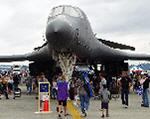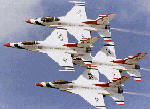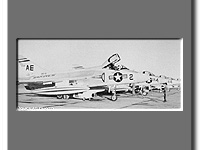
|
Description
| Manufacturer: | North American |
| |
| Base model: | F-6 | ||
| Designation: | F-6 | ||
| Version: | A | ||
| Nickname: | Mustang | ||
| Designation System: | U.S. Air Force | ||
| Designation Period: | 1930-1947 | ||
| Basic role: | Photographic | ||
Specifications
| Not Yet Available |
Examples of this type may be found at
| Museum | City | State |
| Fred E. Weisbrod Museum / International B-24 Museum | Pueblo | Colorado |
| Patuxent River Naval Air Museum | Patuxent River | Maryland |
F-6A on display
Recent comments by our visitors
| Roy Owenby Franklin, NC | I served with VFAW-3 from June 1959 to June 1962. I was an AQF2 in the radar shop. I served with the detachments to Key West, FL and Yuma, AZ. I really enjoyed serving with my peers, all the other shops and the pilots. We did win a lot of awards, see a lot of celebrities and did a good job of serving our country all because of all the excellent and skilled people who watched the skies 24/7. I was and still am proud of my squadron. I wish someone would send me information about the upcoming reunion in June, 08.
Roy Owenby 04/03/2008 @ 04:44 [ref: 20325] |
| Chuck Van Winkle, USN Ret. Congress, AZ | HISTORY OF VF(AW)-3
Decommissioning 1 April 1963 Eight years ago in 1955 All Weather Fighter Squadron THREE (then Fleet All-Weather Training Unit, Pacific) based at NAS, North Island, San Diego, California, assumed the responsibly it of air defense for the southwestern section of the United States under the Continental Air Defense Command. The aircraft employed were Douglas F3D Skyknights, brandishing 20MMcannons. These planes were later replaced for air defense duty in 1958 by the Douglas Skyrays and equipped with the Sidewinder missile. !n 1959, VF(AW)-3 was awarded its first Air Defense prize, the Western Air Defense Force "A" for Achievement. The award was won again in 1960. The squadron won the highest award in "Operation TOP GUN", the Navy Weapons Meet in 1959, taking the James Forrestal Memorial Trophy. The Chief of Naval Operations Aviation Safety Award was earned by the squadron for the years 1960 and 1961. In 1961, VF(AW)-3won the highest award in the Continental Air Defense Command, the ADC"A". During the 1962 Hughes Night Fighter Association competition VF(AW)-3 completed the greatest number of high speed, high altitude intercepts of any squadron in the world. Military preparedness dictated that VF(AW)-3should extend its protection of the skies to the southeastern shore of the nation. Accordingly, in July 1961, Detachment ECHO was formed and deployed to the southeastern tip of the United States. VF(AW)-3was spread across a continent at battle stations, in the fog of North Island and the tropical heat .of Key West, alert and ready to protect our country against the threat of enemy air attack. This expanded alert posture was maintained continuously for eighteen months through calm and crisis, during which time a total of 551 active scrambles were flown under every conceivable condition. It is with pride that we point to the record of Detachment ECHO during the Cubancrisis. For 27 days, with an average availability of six aircraft, a total of 36 sorties and 600 flight hours were accomplished with a perfect safety record. April 1963 will bring to a close the brilliant career of All Weather Fighter Squadron THREE with its distinctively marked aircraft, excellent radar, and expert pilots and ground crews. It stands now at the top of the heap, a standard for other units to follow. Wherever we go, whatever we shall face, out motto is ever this, "With a steady hand, a stout heart and God's help we shall always be on alert, ready to race to the challenge whenever destiny sounds a horn for us." Chuck Van Winkle - 1962 - 1963 10/28/2007 @ 14:21 [ref: 18330] |
| Richard Poirier Arlington Heights, IL | Between '61 and '62 I was assigned as AQF-2 to the Key West detachment of VFAW-3 and was ASDO when an Air Force pilot, temporarily assigned, landed in the arresting gear of the Boca Chica Naval Air Station by accident and miraculously walked away, apparently unhurt. I also remember that, after October '62, President Kennedy reviewed the troops, which was quite a thrill at the time. Anyone who wishes to talk to me about the same experiences, contact me at my email address.
Regards, R. K. Poirier Former AQF-2 05/22/2007 @ 05:52 [ref: 16560] |
| Edward Ray Redding, CA | Oh, such a long time ago. I served in VFAW-3 from Sept, 58 to Apr, 60 as an AQ. I left as an AQ2. I came in with a group from AQ School in Memphis (Bob Bollinger, Vic Waller, Wayne Welch, Len Barton, Gary, Obert, and Dave Snyder – died in a motorcycle accident on the Silver Strand in ’59.) I was selected for the first Seaman Guard unit within a week of my arrival. We were barracked somewhere out by the main gate but moved to barracks across from the chow hall. We rode the “blue bus” to the squadron area until the move.
Some things that I remember: The Ford hellhole. A dark and extremely hot place to stow the fire control computer for the APQ50 radar. I recall that, while at Yuma in ’59, I had to strap an air conditioning duct between my legs in order to climb in there and adjust the “pots”. Losing three Fords and three pilots in ’59. One out-to-sea on a nighttime scramble, one crashing on landing an North Island, and one in Yuma. Obert firing three shots from his M1 carbine at the flightline sweeper in ’59. The weekly practice scrambles (it seemed like weekly) for guest VIPs. I had the dubious honor of causing one to be aborted because I was in the cockpit of one Ford (No. 5) attempting to repair a loose knob that wasn’t loose when the alert sounded. The next thing that I knew was that a pilot came pounding up the ladder, saw me, cursed, and walked away. It seems that the “squawk” sheet had the wrong aircraft number. The radar shop’s chief was CPO Kashuda. There were some F3Ds on flight status in ’58. Port and Starboard duty during readiness inspections. Standing guard duty out by the missile lockers Terrific stuffed pork chops at the chow hall 04/23/2007 @ 09:34 [ref: 16281] |
| John Caslin Twin Lakes, WI | Served with VFAW-3 from '59 to '62 starting in the seaman guard then to the metal shop , was the pinch-hit painter also ( did a lot of drop tank's ) and pilot's helmets . was on the first group to Key West and remember being rotated back to North Island --on a national airlines plane with Desi Arnez on board --he offered to buy all of us a drink but the officer in charge said no --RAT !! 04/17/2007 @ 19:02 [ref: 16214] |
| Kurt Gibson Va Beach, VA | This may be of interest to those of you who served with VFAW-3. I have a manufactures data plate from F4D-1 buno 134850 that was assigned to VFAW-3 in at least 1957. The nose number was 22 and tail code TT. I have been looking for a long time to find out anything about this aircraft. The aircraft was in the end used in a fire dump for training. Other than this I have nothing else on it. If anyone can remember this aircraft or by some remote chance you have a picture I would love to have a copy to frame with the data plate. If you would like a photo of the data plate just e-mail me.
Thank you for your service to our country. Kurt Gibson kurtgibson01@hotmail.com 03/19/2007 @ 15:24 [ref: 15954] |
| Bri Derbyshire Ripon, Yorkshire, ON | Are you all quite mad? I tune in looking for early Mustangs - P-51-1s, AKA F-6As - and the text is there, but all the photos are of Fords - F4Ds - by Douglas, no less.
Your form won't accept my State as Other (that's the only possible answer on your list) - for Ontario, please read Yorkshire! Dearie, dearie me. 01/12/2007 @ 08:22 [ref: 15164] |
| Francis Hajdas Adams, MA | I served with VF(AW) 3 from spring of 1958 to July 1959. I remember the squadron stationed at the end of the runway. While I was there they put up the fences and had 24 hour guard details because of the sidewinder missles. Then they would bring in the dogs when we had the 48 hour practice alerts. I was a ATR 2 working out of the radar shop on the fire control radar. Could not remember the designation of the plane until I just happend to do a search for the squadron today and saw the picture posted by Jeff Malone. Some of you make reference that you were air force pilots. When I was there we were strictly a navy outfit and do not recall any of the pilots to be air force personell. I can remember working night duty and watching the afterburners kicking in as they were going down the runway on a scramble. Quite a site at night. We had a game of trying to guess who the pilot was by the ascent they made. Some guys would literaly set the plane on end and go almost straight up. 01/04/2007 @ 12:59 [ref: 15099] |
| Lyle Daugherty Indianapolis, IN | I served in VFAW3 from the end of 1959 to July 18, 1961. I was a AQF2 in the Radar Shop. I have the picture of CO accepting the TOPGUN trophy in 1960. I was the one that was left in charge with 2 SNs and the two F4Ds that were not RFF when the whole squadron deployed to Key West. I was discharged on the 18th (my 21st birthday), left the senior SN in charge and came home. I worked at NAFI in Indy for 30 years before retiring from Navy (Civil Ser.) Remember they were the manufacturer for the MK 86 firecontrol computer that mounted in the F4's "HELL HOLE" Have vivid memories of those days on the flight line and in the shop. Recall "scrambles", "ABC Drills" and riding "cattle cars", gedunks, midnight chow, compartment cleaning? 08/11/2006 @ 08:05 [ref: 13856] |
| Ken Rowntree Tacoma, WA | I was an Air Force pilot assigned to VFAW3 from July 61 to March 63. Need to get info regarding the accident that I had in Nov or Dec 62 when landing at Boca Chico. The runway landing direction had just been changed and my tail hook inadvertantly engaged the arresting gear the wrong way taking off the tail section from the ejection seat back. I need date if accident, A/C number, any photos, or whatever you have.
Thanks Ken Rowntree 07/11/2006 @ 20:41 [ref: 13710] |
Recent photos uploaded by our visitors








